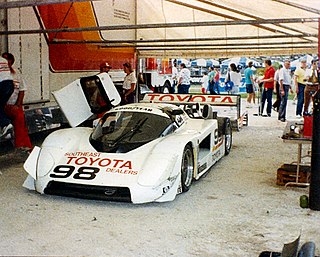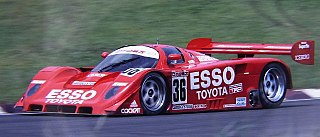
Tamiya Incorporated is a Japanese manufacturer of plastic model kits, radio-controlled cars, battery and solar powered educational models, sailboat models, military vehicle models, acrylic and enamel model paints, and various modeling tools and supplies. The company was founded by Yoshio Tamiya in Shizuoka, Japan, in 1946.

A Le Mans Prototype (LMP) is a type of sports prototype race car used in various races and championships, including the 24 Hours of Le Mans, FIA World Endurance Championship, IMSA SportsCar Championship, European Le Mans Series, and Asian Le Mans Series. Le Mans Prototypes were created by the Automobile Club de l'Ouest (ACO). The technical requirements for an LMP include bodywork covering all mechanical elements of the car. As of 2023, there are two classes within Le Mans Prototypes, designated LMP2 and LMP3.

Group C was a category of sports car racing introduced by the FIA in 1982 and continuing until 1993, with Group A for touring cars and Group B for GTs.

Ryan Dalziel is a Scottish professional racing driver. Dalziel has seen the most success in his career in the United States, racing in the American Le Mans Series GT1 class and the Champ Car World Series, and winning the 2010 24 Hours of Daytona.

The Toyota TS010 was a Group C racing car built by Toyota for the Sportscar World Championship, All Japan Sports Prototype Championship, and the 24 Hours of Le Mans.

Dome Co. Ltd, literally "child's dream", is a Japanese racing car constructor involved mainly in open-wheel and sports car racing.

TOM'S Inc. is an automotive aftermarket parts manufacturer and tuner of Toyota and Lexus vehicles, as well as a factory-backed racing team. The TOM'S head office is located in Tokyo, Japan.
Masanori Sekiya is a Japanese former racing driver, most famous for being the first Japanese driver to win the 24 Hours of Le Mans, in 1995.

SARD Corporation is a Japanese tuning company and racing team from Toyota, Aichi, mainly competing in the Super GT series and specializing in Toyota tuning parts.

The Toyota 88C was a racing car entered by Toyota from 1988 to 1989. It is the successor to the Toyota 87C and the predecessor to the Toyota 88C-V. Like other Toyota-powered sports prototypes of the era, it was designed and built by Dome. The 88C is an evolution of the 87C, both models sharing the same chassis number designation. The 88Cs competed in the All Japan Sports Prototype Championship, the World Sports-Prototype Championship, and the North American Camel GT Championship.
Lars Eje Elgh is a Swedish racing driver and television reporter. He currently works as an expert commentator for Formula One in Sweden together with Janne Blomqvist. The two have worked together as Formula One commentators for a long time, first for TV4 and then for Viasat Motor when they took over the Formula One broadcasting in Sweden.
The Toyota Celica Liftback Turbo was a Group 5 Special Production racecar version of the 3-door liftback first generation Toyota Celica GT built by Schnitzer via Toyota Deutschland to compete in Division 1 of the DRM.

The Toyota 92C-V was a prototype racing car built by Toyota as a Group C car, and later as an LMP car. It raced in the 24 Hours of Le Mans for three years. It also took part in the final year of the All Japan Sports Prototype Championship during the 1992 season.
The 1992 All Japan Sports Prototype Car Endurance Championship was the tenth and final season of the All Japan Sports Prototype Championship, which would be replaced by the All Japan Grand Touring Car Championship, as sportscar racing in the early 1990s changed drastically with the decline of prototypes. The C1 class champion was the #1 Nissan Motorsports Nissan R92CP driven by Kazuyoshi Hoshino and the C class champion was the #7 and #36 TOM'S Toyota TS010 driven by Geoff Lees.
The TOM's Toyota LMP was a Le Mans Prototype built by Toyota. A very low budget effort, the car reused the 2.1-litre turbocharged straight-four engine from Toyota's Group C cars and was intended as an experimental car. It never raced, although it was tested on at least three occasions.

The Toyota 87C, also known as the TOM'S 87C, was a Group C prototype sports car, designed, developed and built by Toyota, for use in sports car racing, specifically the World Sportscar Championship, between 1987 and 1988.

The Toyota 89C-V is a Group C sports prototype racing car, developed and built by Toyota intended to participate in the World Sportscar Championship, the 24 Hours of Le Mans, and the All-Japan Japanese Sports-Prototype Championship. The chassis is designed by Japanese company Dome. It is powered by a turbocharged 3.2 L (200 cu in) Toyota R32 V8 engine, producing 800 hp (600 kW). It won 2 races, scored 4 podium finishes, and clinched 3 pole positions.

The Toyota 91C-V is a Group C sports prototype racing car, developed and built by Toyota intended to participate in the World Sportscar Championship, the 24 Hours of Le Mans, and the All-Japan Japanese Sports-Prototype Championship. It is an evolution of the previous 90C-V. Its powerplant is a turbocharged 3.2–3.6 L (200–220 cu in) Toyota V8 engine, producing 800 hp (600 kW). It won 3 races, achieved 6 podium finishes, and scored 3 pole positions. At a speed of 200 mph (320 km/h), it is capable of producing over 5,000 lbf (22,000 N) of downforce.
The TOM'S 83C was a Group C sports prototype race car, designed, developed and built by TOM'S, in partnership and collaboration with Toyota, for the World Sportscar Championship, All Japan Sports Prototype Championship, and the 24 Hours of Le Mans, in 1983.












